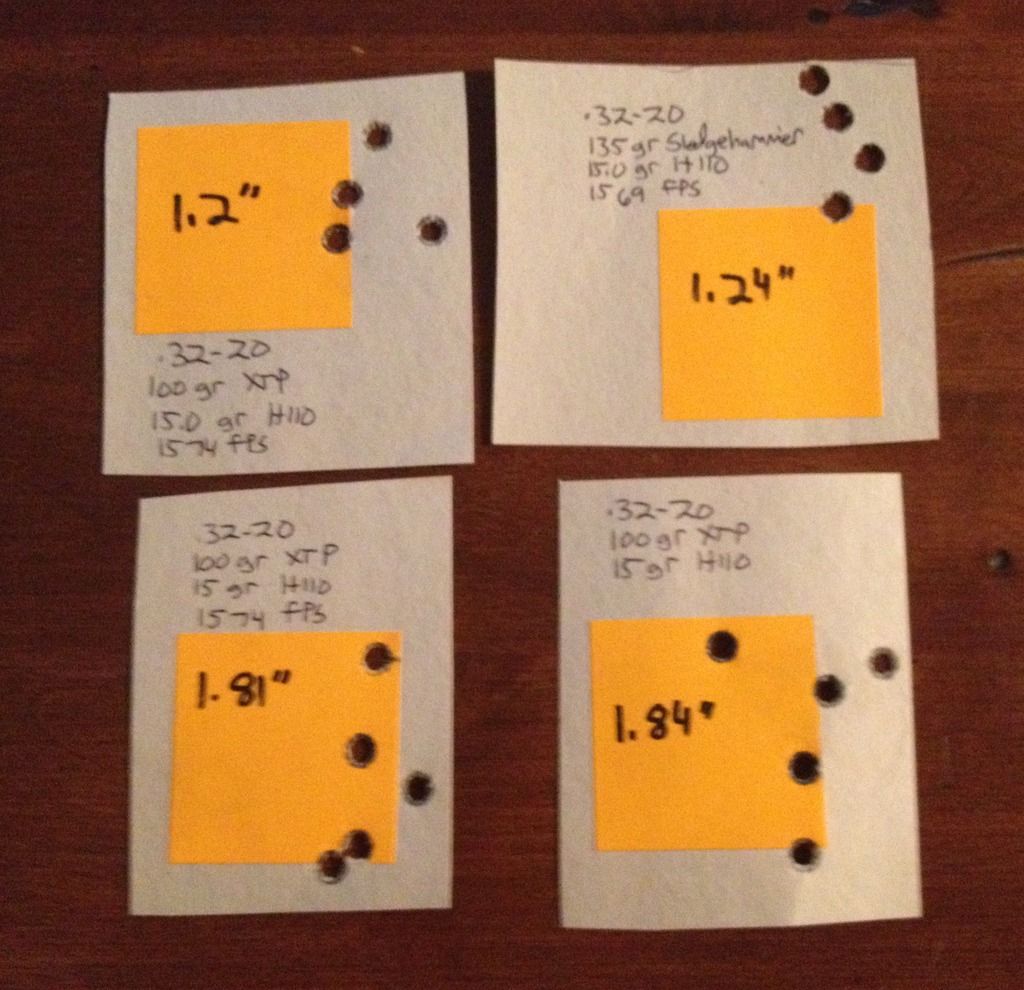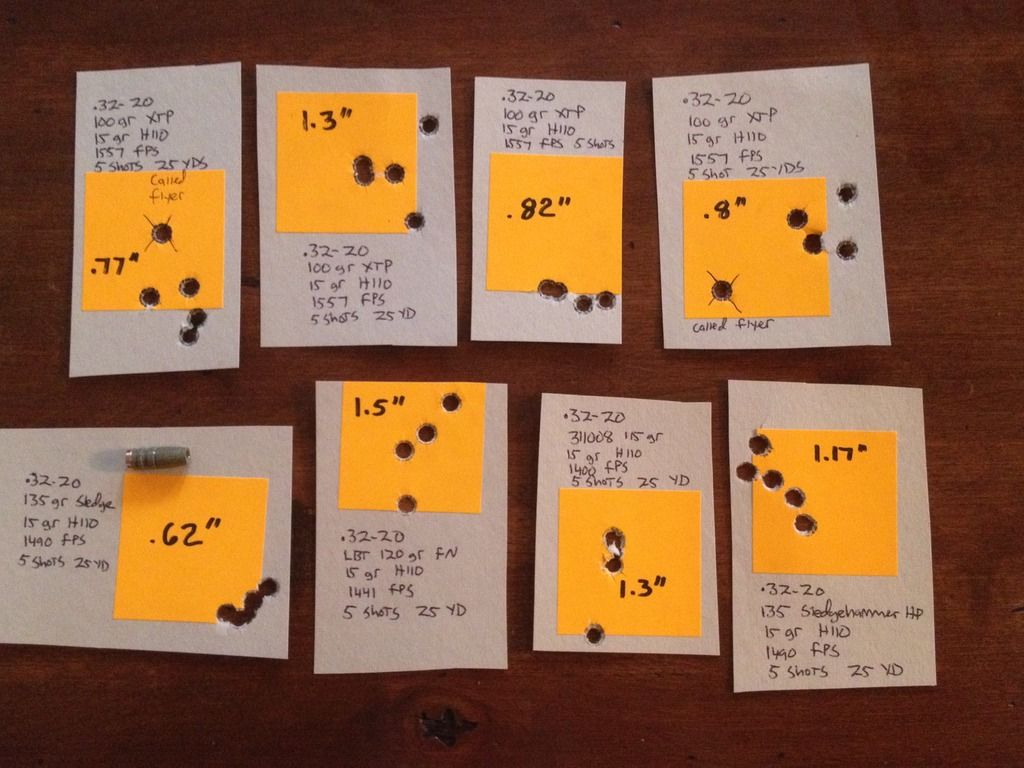2 Dogs Sledgehammer rides in style in vintage case
Mar 24, 2015 21:51:51 GMT -5
reflex264 and Ramar like this
Post by hoover on Mar 24, 2015 21:51:51 GMT -5
I recently read an article by John Taffin on the .32-20 Winchester where he explains it is one of his favorite cartridges because two of his favorite mentors started cutting their eye- teeth on it when they were youngsters. Those two gentlemen just happen to be Elmer Keith and Skeeter Skelton. Coincidentally, I have immense respect for both of Mr. Taffin’s hero’s, along with a deep affection for Mr. Taffin himself. Another favorite also wrote about the start of his handgunning career shooting this cartridge, one I immensely enjoy, that being a Mr. Paco Kelly. He wrote of long summer vacations at his grandfather’s farm in New York, who he affectionately called the “old man.” His grandfather gave Paco free reign on an old 4” nickel-plated S&W .32-20. Paco talked of handloading this cartridge to keep him busy using a home made dipper from a spent .22 shell and bailing wire handle, some bullseye powder, and home cast slugs. A man after my own heart, he knew he had to do these things to be able to shoot as much as he did with his meager allowance.
I’ve been known to be a day late and a dollar short, but I eventually get to where I am going. I always shied away from the .32-20, thinking the bottleneck design to be too much of a hassle to handload. Then one day a stout Mexican bandito with the alias, 2 Dogs, surprised me with a Marlin 1894 lever gun chambered in the antiquated cartridge. As I said, I had read everything Paco Kelly had written, including the .32-20 articles. I also know that a lot of experienced gunmen raved about the old warhorse. Thus began my adventure with the classic bottleneck.
The following year a good friend from Louisiana surprised me with a Ruger Buckeye! I shot it some, but wasn't real impressed with its accuracy. Didn't matter if it was cast bullets, or the new fangled jacketed slugs, fast or slow, the gun did not want to shoot! It wasn't until good friend Fermin Garza, aka 2 Dogs, head honcho of Team .32 caliber, designed his heavy for caliber, beast of a bullet, "Sledgehammer" hollow pointed slug, that I decided to wring out this Ruger Buckeye. After the first session, the Buckeye didn't let me down. It shot like crap! Cast loads went into mostly 2-3" groups at 25 yards, and jacketed bullets were worse. Sheriff Russ Cottle mentioned that his Buckeye suffered from small cylinder throats, and this stuck in back of my mind. While cleaning my Buckeye, I checked the throats with a Hornady 100 gr XTP slug. Not even close to entering the mouth! No wonder it wouldn't shoot. If a .312" bullet won't fit in the cylinder mouth, it is being sized down to that mouths dimension. If bore size is larger than cylinder mouth, this is detrimental to any kind of accuracy.
I know many will cringe at this next phase. I'm a do it your selfer, and decided to polish out my cylinder throats myself. I have done about a dozen of my Ruger .45 Colts with the method I'm about to describe, with excellent results each time. I have also done my Ruger .32 H&R and SP101 in same caliber. It works!
The method I use involves a hand drill, emery cloth, and a steel rod with a slit cut in the end with a hacksaw. You wrap your emery cloth around the steel rod, using the slit to start, and tightly wrap it around until it makes a snug fit into the throat, FROM THE CHAMBER END! What I call gyroscopic effect will keep the steel rod centered in the throat worked on, as you hold the cylinder in your hand. Periodically check your progress with a properly sized bullet. In this case, I chose a .314" Sledgehammer, with GC, as my pin gauge. When thumb pressure pushed it thru the mouth end, I moved to the adjacent hole. I get really consistent results using this method. I don't like shipping guns, waiting or spending unnecessary money. To each his own!
Here are some recent groups shot with the Buckeye BEFORE the cylinder throats were polished out. These were the best it could do. I didn’t bother keeping most of the groups, as I said, they ran in the 2-3” range, or worse.

Here are the AFTER groups. Polishing out the throats worked like a charm. Interestingly, I lost 80 fps after enlarging the throats. Small price for much improved accuracy. Now you may wonder, with .314” throats, how do .312” jacketed bullets shoot? Look for yourself. They shoot wonderfully!

With powder residue stained hands, and a new sense of accomplishment, I started packing up my gear with a smug look on my face. My Buckeye and I were now the best of friends. Sometimes all it takes is a little nip and tuck, some good bullets and loads, and an old dog becomes a pedigree. Old cartridge? Yep! Invigorated with new loads? Yep, again! Then again, it should come as no surprise, as many great men before me knew what a dandy cartridge this was!
I’ve been known to be a day late and a dollar short, but I eventually get to where I am going. I always shied away from the .32-20, thinking the bottleneck design to be too much of a hassle to handload. Then one day a stout Mexican bandito with the alias, 2 Dogs, surprised me with a Marlin 1894 lever gun chambered in the antiquated cartridge. As I said, I had read everything Paco Kelly had written, including the .32-20 articles. I also know that a lot of experienced gunmen raved about the old warhorse. Thus began my adventure with the classic bottleneck.
The following year a good friend from Louisiana surprised me with a Ruger Buckeye! I shot it some, but wasn't real impressed with its accuracy. Didn't matter if it was cast bullets, or the new fangled jacketed slugs, fast or slow, the gun did not want to shoot! It wasn't until good friend Fermin Garza, aka 2 Dogs, head honcho of Team .32 caliber, designed his heavy for caliber, beast of a bullet, "Sledgehammer" hollow pointed slug, that I decided to wring out this Ruger Buckeye. After the first session, the Buckeye didn't let me down. It shot like crap! Cast loads went into mostly 2-3" groups at 25 yards, and jacketed bullets were worse. Sheriff Russ Cottle mentioned that his Buckeye suffered from small cylinder throats, and this stuck in back of my mind. While cleaning my Buckeye, I checked the throats with a Hornady 100 gr XTP slug. Not even close to entering the mouth! No wonder it wouldn't shoot. If a .312" bullet won't fit in the cylinder mouth, it is being sized down to that mouths dimension. If bore size is larger than cylinder mouth, this is detrimental to any kind of accuracy.
I know many will cringe at this next phase. I'm a do it your selfer, and decided to polish out my cylinder throats myself. I have done about a dozen of my Ruger .45 Colts with the method I'm about to describe, with excellent results each time. I have also done my Ruger .32 H&R and SP101 in same caliber. It works!
The method I use involves a hand drill, emery cloth, and a steel rod with a slit cut in the end with a hacksaw. You wrap your emery cloth around the steel rod, using the slit to start, and tightly wrap it around until it makes a snug fit into the throat, FROM THE CHAMBER END! What I call gyroscopic effect will keep the steel rod centered in the throat worked on, as you hold the cylinder in your hand. Periodically check your progress with a properly sized bullet. In this case, I chose a .314" Sledgehammer, with GC, as my pin gauge. When thumb pressure pushed it thru the mouth end, I moved to the adjacent hole. I get really consistent results using this method. I don't like shipping guns, waiting or spending unnecessary money. To each his own!
Here are some recent groups shot with the Buckeye BEFORE the cylinder throats were polished out. These were the best it could do. I didn’t bother keeping most of the groups, as I said, they ran in the 2-3” range, or worse.

Here are the AFTER groups. Polishing out the throats worked like a charm. Interestingly, I lost 80 fps after enlarging the throats. Small price for much improved accuracy. Now you may wonder, with .314” throats, how do .312” jacketed bullets shoot? Look for yourself. They shoot wonderfully!

With powder residue stained hands, and a new sense of accomplishment, I started packing up my gear with a smug look on my face. My Buckeye and I were now the best of friends. Sometimes all it takes is a little nip and tuck, some good bullets and loads, and an old dog becomes a pedigree. Old cartridge? Yep! Invigorated with new loads? Yep, again! Then again, it should come as no surprise, as many great men before me knew what a dandy cartridge this was!



